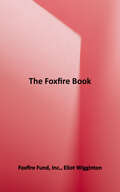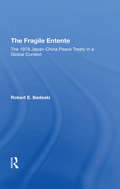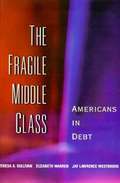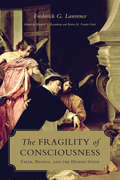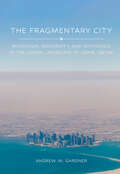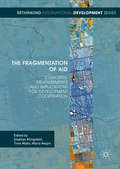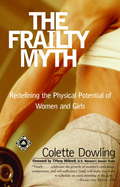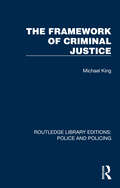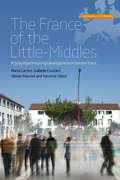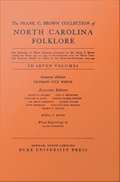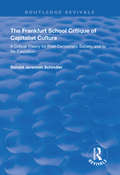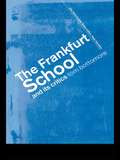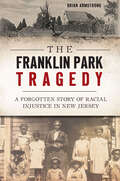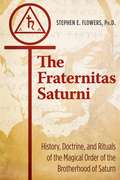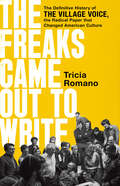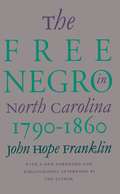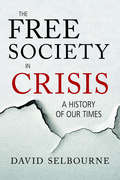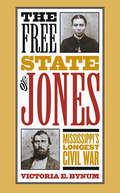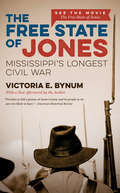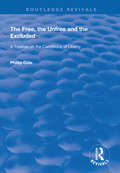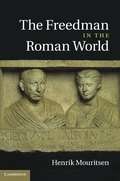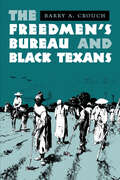- Table View
- List View
The Foxfire Book: Hog Dressing, Log Cabin Building, Mountain Crafts and Foods, Planting by the Signs, Snake Lore, Hunting Tales, Faith Healing, Moonshining, and Other Affairs of Plain Living
by Inc. Foxfire FundFirst published in 1972, The Foxfire Book was a surprise bestseller that brought Appalachia's philosophy of simple living to hundreds of thousands of readers. Whether you wanted to hunt game, bake the old-fashioned way, or learn the art of successful moonshining, The Foxfire Museum and Heritage Center had a contact who could teach you how with clear, step-by-step instructions. This classic debut volume of the acclaimed series covers a diverse array of crafts and practical skills, including log cabin building, hog dressing, basket making, cooking, fence making, crop planting, hunting, and moonshining, as well as a look at the history of local traditions like snake lore and faith healing.
The Fragile Bridge: Paterson Silk Strike, 1913
by Steve GolinIn 1913 skilled and unskilled workers in the silk industry of Paterson, New Jersey, joined forces to strike for better wages and working conditions. The International Workers of the World, or IWW, supported the strike, as did a group of left-leaning artists and writers from New York's Greenwich Village. This highly unusual coalition of workers and intellectuals formed the "fragile bridge" of the title, culminating in a spectacular pageant portraying the strike, held in Madison Square Garden. This book tells the story of the strike in rich detail and shows how its ultimate failure led to the collapse of the IWW.
The Fragile Entente: The 1978 Japan-china Peace Treaty In A Global Context
by Robert E BedeskiBetween early 1978 and late 1980, power relationships in the Pacific region underwent historic transformation. Deng-Xiaoping, re-emerging as a key leader in the People's Republic of China, demonstrated pragmatism in domestic and foreign policy. Beijing negotiated a Peace and Friendship Treaty with Japan, apparently opening an era of Sino-Japanese economic cooperation. Moscow viewed this development with alarm, fearing it would lead to a three-way alliance including the United States. Meanwhile, Japan foreswore any military significance in closer links with the PRC, but by succumbing to the Chinese demand for inclusion of a treaty clause denouncing Soviet hegemony, became an involuntary participant in the Sino-Soviet conflict. In this environment, the Sino-Japanese treaty-- which might have been an innocuous footnote to postwar history--became an event marking a new phase in East Asian affairs. Dr. Bedeski draws on Chinese, Soviet, and Japanese sources to clarify the relationships among the wide range of events ensuing from the treaty and points to its relevance to a new era of Sino-Soviet relations. The irony of the Peace and Friendship Treaty, he concludes, is that_it probably was a catalyst of insecurity and hostility in the region and that it became an important event leading to the participation of non-Communist actors--Japan, the U.S., and NATO-- in the Sino-Soviet conflict
The Fragile Middle Class: Americans in Debt
by Elizabeth Warren Teresa A. Sullivan Jay Lawrence WestbrookThis book is about the middle class as viewed through the lens of bankruptcy. Since 1997, the number of American families filing for federal bankruptcy annually has exceeded one million. By most measures, those who file are members of the middle class -- a group that has long provided stability and vitality for the American economic system. This raises the troubling question: why, during the most remarkable period of prosperity in our history, are unprecedented numbers of Americans encountering such serious financial trouble?The authors of this important book analyze court records and demographic data on thousands of bankruptcy cases, as well as debtors' own poignant accounts of the reasons for their bankruptcies. For many middle-class Americans, the findings show, financial stability is fragile -- almost any setback can be disastrous. The erosion of job stability, divorce and family instability, the visible and invisible costs of medical care, the burden of home ownership, and the staggering weight of consumer debt financed with plastic combine to threaten the financial security of growing numbers of middle-class families. The authors view the bankruptcy process in the light of changing cultural and economic factors and consider what this may signify for the future of a large, secure, and dynamic middle class.
The Fragility of Consciousness: Faith, Reason, and the Human Good
by Frederick Lawrence Kevin Vander Schel Randall S. RosenbergFrederick G. Lawrence is the authoritative interpreter of the work of Bernard Lonergan and an incisive reader of twentieth-century continental philosophy and hermeneutics. The Fragility of Consciousness is the first published collection of his essays and contains several of his best known writings as well as unpublished work. The essays in this volume exhibit a long interdisciplinary engagement with the relationship between faith and reason in the context of the crisis of culture that has marked twentieth- and twenty-first century thought and practice. Frederick G. Lawrence, with his profound and generous commitment to the intellectual life of the church, has produced a body of work that engages with Heidegger, Gadamer, Habermas, Ricoeur, Strauss, Voegelin, and Benedict XVI among others. These essays also explore various themes such as the role of religion in a secular age, political theology, economics, neo-Thomism, Christology, and much more. In an age marked by social, cultural, political, and ecclesial fragmentation, Lawrence models a more generous way – one that prioritizes friendship, conversation, and understanding above all else.
The Fragmentary City: Migration, Modernity, and Difference in the Urban Landscape of Doha, Qatar
by Andrew M. GardnerAs Andrew M. Gardner explains in The Fragmentary City, in Qatar and elsewhere on the Arabian Peninsula, nearly nine out of every ten residents are foreign noncitizens. Many of these foreigners reside in the cities that have arisen in Qatar and neighboring states. The book provides an overview of the gulf migration system with its diverse migrant experiences. Gardner focuses on the ways that demography and global mobility have shaped the city of Doha and the urban characteristics of the Arabian Peninsula in general. Building on those migrant experiences, the book turns to the spatial politics of the modern Arabian city, exploring who is placed where in the city and how this social landscape came into historical existence. The author reflects on what we might learn from these cities and the societies that inhabit them. In The Fragmentary City, Andrew M. Gardner frames the contemporary cities of the Arabian Peninsula not as poor imitations of Western urban modernity, but instead as cities on the frontiers of a global, neoliberal, and increasingly urban future.
The Fragmentation of Aid
by Stephan Klingebiel Timo Mahn Mario NegreThis edited volume provides an assessment of an increasingly fragmented aid system. Development cooperation is fundamentally changing its character in the wake of global economic and political transformations and an ongoing debate about what constitutes, and how best to achieve, global development. This also has important implications for the setup of the aid architecture. The increasing number of donors and other actors as well as goals and instruments has created an environment that is increasingly difficult to manoeuvre. Critics describe today's aid architecture as 'fragmented': inefficient, overly complex and rigid in adapting to the dynamic landscape of international cooperation. By analysing the actions of donors and new development actors, this book gives important insights into how and why the aid architecture has moved in this direction. The contributors also discuss the associated costs, but also potential benefits of a diverse aid system, and provide some concrete options for the way forward.
The Fragrance of Sweet-Grass
by Elizabeth Rollins EpperlyWhen it originally appeared, Elizabeth Rollins Epperly's The Fragrance of Sweet-Grass was one of the first challenges to the idea that L.M. Montgomery's books were unworthy of serious study. Examining all of Montgomery's fiction, Epperly argues that Montgomery was much more than a master of the romance genre and that, through her use of literary allusions, repetitions, irony, and comic inversions, she deftly manipulated the normal conventions of romance novels. Focusing on Montgomery's memorable heroines, from Anne Shirley to Emily Byrd Starr, Valancy Stirling, and Pat Gardiner, Epperly demonstrates that Montgomery deserves a place in the literary canon not just as the creator of Anne of Green Gables but as an artist in her chosen profession.Since its publication more than twenty years ago, The Fragrance of Sweet-Grass has become a favourite of scholars, writers, and Montgomery fans. This new edition adds a preface in which Epperly discusses the book's contribution to the ongoing research on the life and writing of L.M. Montgomery, reflects on how Montgomery studies have flourished over the past two decades, and suggests new ways to approach and explore the Canadian writer's work.
The Frailty Myth: Redefining the Physical Potential of Women and Girls
by Colette DowlingCan women be equal to men as long as men are physically stronger? And are men, in fact, stronger? These are key questions that Colette Dowling, author of the bestsellingThe Cinderella Complex, raises in her provocative new book. The myth of female frailty, with its roots in nineteenth-century medicine and misogyny, has had a damaging effect on women's health, social status, and physical safety. It is Dowling's controversial thesis that women succumb to societal pressures to appear weak in order to seem more "feminine. " The Frailty Myth presents new evidence that girls are weaned from the use of their bodies even before they begin school. By adolescence, their strength and aerobic powers have started to decline unless the girls are exercising vigorously--and most aren't. By sixteen, they have already lost bone density and turned themselves into prime candidates for osteoporosis. They have also been deprived of motor stimulation that is essential for brain growth. Yet as breakthroughs among elite women athletes grow more and more astounding, it begins to appear that strength and physical skill--for all women--is only a matter of learning and training. Men don't have a monopoly on physical prowess; when women and men are matched in size and level of training, the strength gap closes. In some areas, women are actually equipped to outperform men, due partly to differences in body structure, and partly to the newly discovered strengthening benefits of estrogen. Drawing on extensive research in motor development, performance assessment, sports physi-ology, and endocrinology, Dowling presents an astonishing picture of the new physical woman. And she creates a powerful argument that true equality isn't possible until women learn how to stand up for themselves--physically.
The Framework of Criminal Justice (Routledge Library Editions: Police and Policing)
by Michael KingIn The Framework of Criminal Justice, originally published in 1981, the criminal justice process is analysed by using six models, each of which expresses a different justification for criminal justice and punishment: the due process model – exacting justice between equal parties; the crime control model – punishing wrong and preventing further crime; the bureaucratic model – controlling crime and criminals; the medical model – rehabilitating offenders; the status passage model – publicly denouncing the crime and criminal; and the power model – maintaining domination by the ruling class and reinforcing class values. The study examines the formal rules and procedures of the magistrate court system within the context of these models and also discusses the roles of the actors (police, defendant, magistrate, court clerks, and lawyers). Next, the study depicts eight scenes that occur from the defendant's arrest through a court hearing to sentencing. It assesses how closely the activity and behaviour within the system follow the formal protections granted by the British system of justice, and it concludes that the process is far more complex and the rules far more open to interpretation than is commonly believed. The book suggests that this miscalculation has led to the failure of various reforms – special attention is given to the Bail Reform Act of 1976 and two sections of the Criminal Law Act of 1977. It further suggests that real reform must depend upon an understanding of the political nature of the criminal justice system.
The France of the Little-Middles: A Suburban Housing Development in Greater Paris (Anthropology of Europe #1)
by Marie Cartier Isabelle Coutant Olivier Masclet Yasmine SiblotThe Poplars housing development in suburban Paris is home to what one resident called the “Little-Middles” – a social group on the tenuous border between the working- and middle- classes. In the 1960s The Poplars was a site of upward social mobility, which fostered an egalitarian sense of community among residents. This feeling of collective flourishing was challenged when some residents moved away, selling their homes to a new generation of upwardly mobile neighbors from predominantly immigrant backgrounds. This volume explores the strained reception of these migrants, arguing that this is less a product of racism and xenophobia than of anxiety about social class and the loss of a sense of community that reigned before.
The Frank С. Brown Collection of North Carolina Folklore
by Newman Ivey WhiteFrank C. Brown organized the North Carolina Folklore Society in 1913. Both Dr. Brown and the Society collected stores from individuals-Brown through his classes at Duke University and through his summer expeditions in the North Carolina mountains, and the Society by interviewing its members-and also levied on the previous collections made by friends and members of the Society. The result was a large mass of texts and notes assembled over a period of nearly forty years and covering every aspect of local tradition.
The Frankfurt School Critique of Capitalist Culture: A Critical Theory for Post-democratic Society and Its Re-education (Routledge Revivals)
by Ronald Jeremiah SchindlerFirst published in 1998, this volume is an impressive contradictory cultural phenomenon. It addresses almost every existing contemporary school of thought whilst belonging completely to none of them through an absence of external signifiers. With remarkable erudition, Ronald Schindler reveals to official society the truth about itself through explorations of areas including the origins of dialectical intelligence, a metatheoretical reconstruction of Marxism, Habermas’ historical materialism and hermeneutics and political visions for the universities.
The Frankfurt School and its Critics (Key Sociologists)
by The late BottomoreThe Institute of Social Research, from which the Frankfurt School developed, was founded in the early years of the Weimar Republic. It survived the Nazi era in exile, to become an important centre of social theory in the postwar era. Early members of the school, such as Adorno, Horkheimer and Marcuse, developed a form of Marxist theory known as Critical Theory, which became influential in the study of class, politics, culture and ideology. The work of more recent members, and in particular Habermas, has received wide attention throughout Europe and North America. Tom Bottomore's study takes a new and controversial look at the contributions of the Frankfurt School to modern sociology, examining several issues not previously discussed elsewhere. He discusses the neglect of history and political economy by the critical theorists, and considers the relationship of the later Frankfurt School to the radical movements of the 1960s and the present time. His critical analysis makes the school's writers accessible, through an assessment of their work and an exploration of the relationship of Critical Theory to other forms of sociological thought, especially positivism and structuralism.
The Frankfurt School, Jewish Lives, and Antisemitism
by Jack JacobsThe history of the Frankfurt School cannot be fully told without examining the relationships of Critical Theorists to their Jewish family backgrounds. Jewish matters had significant effects on key figures in the Frankfurt School, including Max Horkheimer, Theodor W. Adorno, Erich Fromm, Leo Lowenthal and Herbert Marcuse. At some points, their Jewish family backgrounds clarify their life paths; at others, these backgrounds help to explain why the leaders of the School stressed the significance of antisemitism. In the post-Second World War era, the differing relationships of Critical Theorists to their Jewish origins illuminate their distinctive stances toward Israel. This book investigates how the Jewish backgrounds of major Critical Theorists, and the ways in which they related to their origins, impacted upon their work, the history of the Frankfurt School, and differences that emerged among them over time.
The Franklin Park Tragedy: A Forgotten Story of Racial Injustice in New Jersey (True Crime Ser.)
by Brian ArmstrongHistorian Brian Armstrong tells the shocking story of this &“sundown town&” and how it evolved into the diverse community that exists today. On March 1, 1894, two African American men broke into a home in rural Franklin Park, New Jersey. and murdered a white woman and her daughter before her husband fought and killed the attackers. The newspapers called it the &“Franklin Park Tragedy,&” and the story captivated public attention nationally and abroad. But another tragedy came afterward, with the racist forced expulsion of many local African American residents.
The Fraternitas Saturni: History, Doctrine, and Rituals of the Magical Order of the Brotherhood of Saturn
by Stephen E. FlowersThe most in-depth work in English on the most influential secret magic group of 20th-century Germany, the Fraternitas Saturni, or Brotherhood of Saturn • Explores the history of the Order from its founding the late 1960s • Transcribes many rituals and practices in such detail that readers will be able to undertake their own experiential work • Examines the Order’s teachings on cosmology, the Kabbalah, the Saturnian Sacraments, electrical magic, and sexual mysticism--the Yoga of the Dark Light • Includes biographies of prominent members, including founder Gregor A. Gregorius, Karl Spiesberger (Frater Eratus), and Albin Grau (Master Pacitius) The most influential magical group in Germany during the 20th century, the Fraternitas Saturni, or Brotherhood of Saturn, is still the most active and important magical society in Germany today. But from its formal beginnings in 1926 in Weimar Berlin until around 1970 it was almost totally secret. Most of what is known about the Order in the English-speaking world is fragmentary and focuses exclusively on the sensational sex-magic practices and Luciferian tendencies of this magical lodge.Presenting the most in-depth work in English on the Fraternitas Saturni, Stephen Flowers examines the history of the Order from the mid-1920s to the late 1960s when the Order was fundamentally reformed. He details their path of initiation, secret doctrines, ritual practices, and magical formulas and offers biographies of the Order’s most prominent members, including founder Gregor A. Gregorius, Karl Spiesberger (Frater Eratus), Albin Grau (Master Pacitius), and Franz Saettler (Dr. Musallam). Exploring the Brotherhood’s guiding principles, he shows that at the heart of Saturnian ideology is the idea of Saturn-Gnosis: the interplay of opposing forces in the universe leading to the realization of the individual self as a god-like entity. He examines the Order’s teachings on cosmology, the Kabbalah, the Saturnian Sacraments, electrical magic, sexo-cosmology, sex-magic rites, and sexual mysticism--the Yoga of the Dark Light--and transcribes many of their actual rituals and practices, including the highly controversial Gradus Pentalphae, in such detail that readers will be able to undertake their own experiential work. Explaining the meanings of all 33 grades of the Order, the author also looks at the infamous Freemasonic Order of the Golden Centurium, the cult of Adonism, the links between Thelema and the Fraternitas Saturni, and the rare teachings of Master Pacitius (Albin Grau), the visual genius behind the film Nosferatu. He also includes rare reports by Aleister Crowley concerning his interaction with some of the forerunners to the Order and letters from the Order’s founder, Gregor A. Gregorius, to the “Great Beast.”
The Freaks Came Out to Write: The Definitive History of the Village Voice, the Radical Paper That Changed American Culture
by Tricia RomanoA rollicking history of America's most iconic weekly newspaper told through the voices of its legendary writers, editors, and photographers. You either were there or you wanted to be. A defining New York City institution co-founded by Norman Mailer, The Village Voice was the first newspaper to cover hip-hop, the avant-garde art scene, and Off-Broadway with gravitas. It reported on the AIDS crisis with urgency and seriousness when other papers dismissed it as a gay disease. In 1979, the Voice&’s Wayne Barrett uncovered Donald Trump as a corrupt con artist before anyone else was paying attention. It invented new forms of criticism and storytelling and revolutionized journalism, spawning hundreds of copycats. With more than 200 interviews, including two-time Pulitzer Prize winner, Colson Whitehead, cultural critic Greg Tate, gossip columnist Michael Musto, and feminist writers Vivian Gornick and Susan Brownmiller, former Voice writer Tricia Romano pays homage to the paper that saved NYC landmarks from destruction and exposed corrupt landlords and judges. With interviews featuring post-punk band, Blondie, sportscaster Bob Costas, and drummer Max Weinberg, of Bruce Springsteen&’s E Street Band, in this definitive oral history, Romano tells the story of journalism, New York City and American culture—and the most famous alt-weekly of all time.
The Free Negro in North Carolina, 1790-1860
by John Hope FranklinJohn Hope Franklin has devoted his professional life to the study of African Americans. Originally published in 1943 by UNC Press, The Free Negro in North Carolina, 1790-1860 was his first book on the subject. As Franklin shows, freed slaves in the antebellum South did not enjoy the full rights of citizenship. Even in North Carolina, reputedly more liberal than most southern states, discriminatory laws became so harsh that many voluntarily returned to slavery.
The Free Society in Crisis: A History of Our Times
by David SelbourneCritiquing assumptions on both the left and the right, noted historian of ideas and political theorist David Selbourne stresses the importance of shared community and civic duty.How stable are free societies today? This book argues that they are under threat from "market free-choice" and "moral free-choice," two sides of the same coin which between them, the author warns, threaten to tear civil society apart. Market free-choice is the prevailing economic ideology that gives free reign to market forces, even when they ride roughshod over communities and whole nations. Moral free-choice, the other side of the coin, is the notion of individual rights without any sense of civic responsibility. The result of such ultra-individualism in economic and moral practice is the malaise we find ourselves in today: a lost sense of place, community, and belonging, as well as dismissiveness and unawareness of the lessons of the past. In the wake of these destructive trends, this book reminds us that personal well-being is dependent in large part upon the maintenance of a coherent civic and moral order. A society consisting of isolated individuals focused solely on personal rights with no regard for the foundation of their freedoms will soon see that foundation crumble through neglect. By the same token, a society that routinely sacrifices equality of opportunity and economic fairness to the forces of the global marketplace creates dangerous tensions between the few haves and the many have-nots. Reminding the reader of the aspirations and largely-forgotten writings of America's founding fathers, the book concludes by pointing to the principles of what the author calls the "true commonwealth" as an alternative to today's political, ethical, and social disorders.
The Free State of Jones
by Victoria E. BynumBetween late 1863 and mid-1864, an armed band of Confederate deserters battled Confederate cavalry in the Piney Woods region of Jones County, Mississippi. Calling themselves the Knight Company after their captain, Newton Knight, they set up headquarters in the swamps of the Leaf River, where, legend has it, they declared the Free State of Jones. The story of the Jones County rebellion is well known among Mississippians, and debate over whether the county actually seceded from the state during the war has smoldered for more than a century. Adding further controversy to the legend is the story of Newt Knight's interracial romance with his wartime accomplice, Rachel, a slave. From their relationship there developed a mixed-race community that endured long after the Civil War had ended, and the ambiguous racial identity of their descendants confounded the rules of segregated Mississippi well into the twentieth century.Victoria Bynum traces the origins and legacy of the Jones County uprising from the American Revolution to the modern civil rights movement. In bridging the gap between the legendary and the real Free State of Jones, she shows how the legend--what was told, what was embellished, and what was left out--reveals a great deal about the South's transition from slavery to segregation; the racial, gender, and class politics of the period; and the contingent nature of history and memory."An original and cogent piece of scholarship on a devilishly complicated and demanding subject."--Washington Times"Bynum deserves much praise for her ability to negotiate the minefield of myth and legend to produce a study that not only makes a tremendous contribution to scholarship but is a compelling read as well. Thoroughly researched, thoughtfully argued, well-written, and unfailingly interesting, Bynum's work further demonstrates the potential of local studies to shed light on broader forces that have shaped the American past."--H-Net"Bynum has fashioned frustratingly disparate material into an important book that may cause historians who are skeptical about putting too much stress on an 'inner' Civil War to rethink their position."--American Historical Review"Powerful, revisionist, and timely, Bynum's book combines superb history with poignant analysis of historical memory and southern racial mores."--ChoicePiercing through the myths that have shrouded the "Free State of Jones," Victoria Bynum uncovers the fascinating true history of this Mississippi Unionist stronghold, widely believed to have seceded from the Confederacy, and the mixed-race community that evolved there. She shows how the legend--what was told, what was embellished, and what was left out--reveals a great deal about the South's transition from slavery to segregation; the racial, gender, and class politics of the period; and the contingent nature of history and memory.-->
The Free State of Jones, Movie Edition: Mississippi's Longest Civil War
by Victoria E. BynumBetween late 1863 and mid-1864, an armed band of Confederate deserters battled Confederate cavalry in the Piney Woods region of Jones County, Mississippi. Calling themselves the Knight Company after their captain, Newton Knight, they set up headquarters in the swamps of the Leaf River, where they declared their loyalty to the U.S. government. The story of the Jones County rebellion is well known among Mississippians, and debate over whether the county actually seceded from the state during the war has smoldered for more than a century. Adding further controversy to the legend is the story of Newt Knight's interracial romance with his wartime accomplice, Rachel, a slave. From their relationship there developed a mixed-race community that endured long after the Civil War had ended, and the ambiguous racial identity of their descendants confounded the rules of segregated Mississippi well into the twentieth century.Victoria Bynum traces the origins and legacy of the Jones County uprising from the American Revolution to the modern civil rights movement. In bridging the gap between the legendary and the real Free State of Jones, she shows how the legend--what was told, what was embellished, and what was left out--reveals a great deal about the South's transition from slavery to segregation; the racial, gender, and class politics of the period; and the contingent nature of history and memory.In a new afterword, Bynum updates readers on recent scholarship, current issues of race and Southern heritage, and the coming movie that make this Civil War story essential reading. The Free State of Jones film, starring Matthew McConaughey, Gugu Mbatha-Raw, and Keri Russell, will be released in May 2016.
The Free, the Unfree and the Excluded: A Treatise on the Conditions of Liberty (Routledge Revivals)
by Phillip ColeFirst published in 1998, this volume forwards a particular theory of freedom and delves into the relationships between this view of freedom and issues of social justice. Exploring positive and negative implications of the idea of freedom and its interaction with social justice programs, Phillip Cole argues that the idea of freedom contributes substantially to the theory of social justice, rather than drawing limiting boundaries around it. Cole examines the concept of freedom in light of ability, autonomy, neutrality, equality, welfare and membership. At heart, his approach is based on the notion of ‘entitlement’ and assumes that all people are of equal moral and political weight, that all should receive the same consideration for the purpose of ethical and political questions.
The Freedman in the Roman World
by Henrik MouritsenFreedmen occupied a complex and often problematic place in Roman society between slaves on the one hand and freeborn citizens on the other. Playing an extremely important role in the economic life of the Roman world, they were also a key instrument for replenishing and even increasing the size of the citizen body. This book presents an original synthesis, for the first time covering both Republic and Empire in a single volume. While providing up-to-date discussions of most significant aspects of the phenomenon, the book also offers a new understanding of the practice of manumission, its role in the organisation of slave labour and the Roman economy, as well as the deep-seated ideological concerns to which it gave rise. It locates the freedman in a broader social and economic context, explaining the remarkable popularity of manumission in the Roman world.
The Freedmen's Bureau and Black Texans
by Barry A. CrouchDrawing on a wealth of previously unused documentation in the National Archives, this book offers new insights into the workings of the Freedmen's Bureau and the difficulties faced by Texas Bureau officials, who served in a remote and somewhat isolated area with little support from headquarters.
